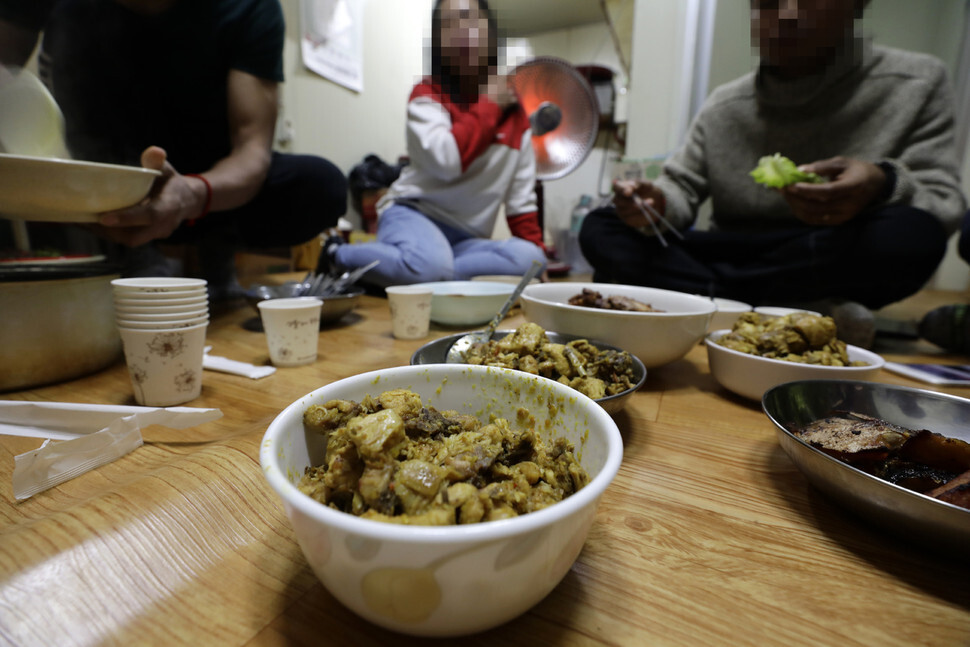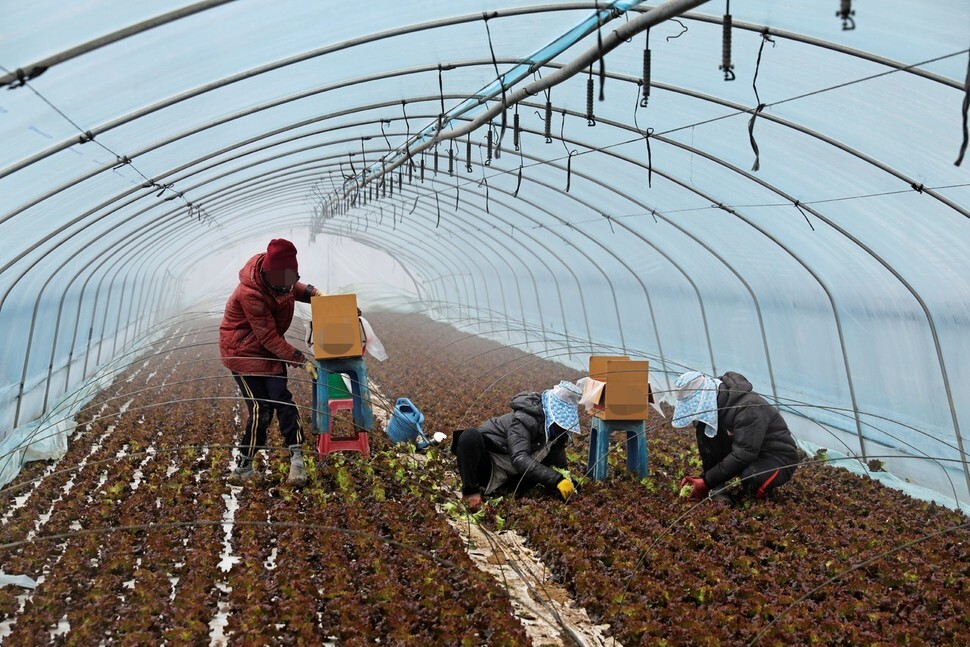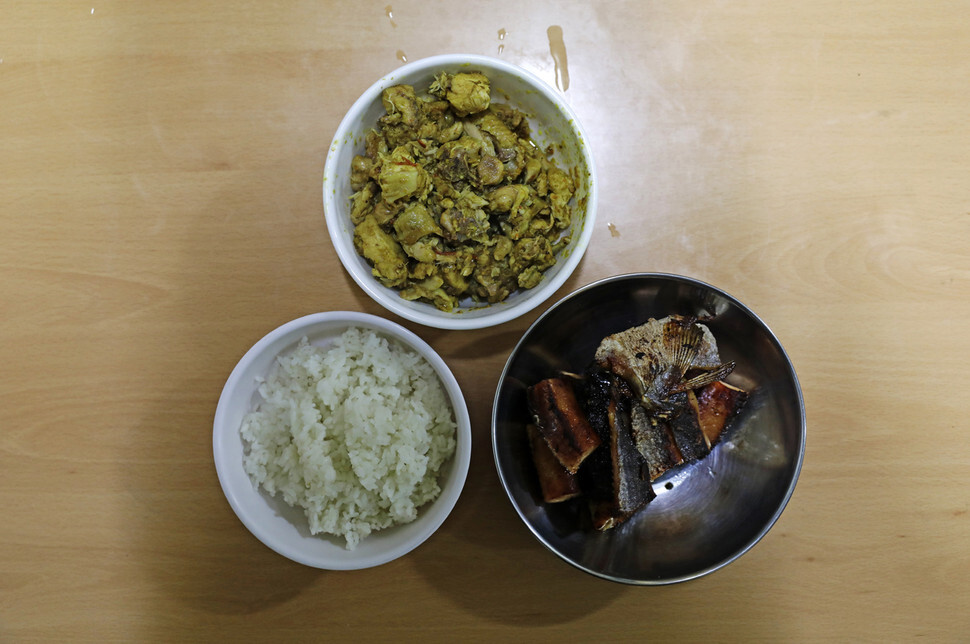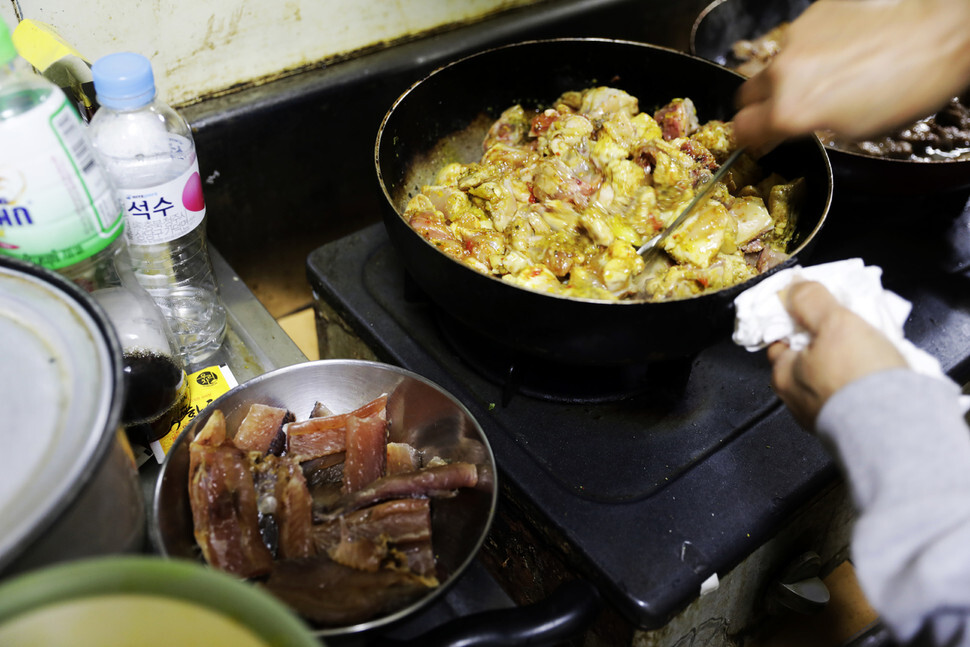hankyoreh
Links to other country sites 다른 나라 사이트 링크
[Reportage] Cambodian workers spend lives of indentured servitude on Korean farms

The woman’s face brightened when the strong aroma of the dried fish reached her nose. It had been a while since Peukka (pseudonym) had tasted pollack.
Dried pollack is a popular side dish in Peukka’s home of Cambodia, with a similar flavor profile to Korean jwipo, a seasoned jerky made of filefish. The fish can often be seen dangling above Cambodian marketplaces, strung up on lines. This is the “soul food” that this 45-year-old eats whenever she feels homesick. She’s been in South Korea for eight years now, doing farming work.
I’d met the Cambodian in a shipping container inside a greenhouse in a Seoul suburb. “We have to work even when we’re sick. We can’t take a break when we have a cold. The best thing to do when I’m feeling sick is to have some pollack and some watery rice,” Peukka said, as she flipped over the pollack in a frying pan.
The frying pan didn’t have a handle, so she had to hold it precariously with rolled up toilet paper. The hood above the stove was stained black from the smoke.
Peukka’s pollack had been brought to the farm by a coworker who’d returned from a trip to Cambodia the day before. A Southeast Asian market nearby sells the dried fish, but for three or four times the price back home. She wasn’t about to pay that much. Thanks to her coworker, though, Peukka was finally going to have a decent meal.
As everyone sat down for a Cambodian-style meal, a smile crossed Peukka’s face, as if she were back home. Except for the fact that she and her friends were in a shipping container, not a house, and that the floor was as cold as ice.

When I got to the greenhouse on the evening of Dec. 12, Peukka and seven other Cambodians were crouched down, picking lettuce. They were all wearing hats, with handkerchiefs wrapped around them, dirt-stained padded jackets, and track pants, as if it was their dress code. The eight Cambodians had 80 greenhouses, which measured 10m wide and 100-150m long, in their care, with each worker responsible for 10 greenhouses.
Cucumbers are grown here in the summer, and lettuce or spinach in the winter. Sixty of the greenhouses are owned by an individual who I’m told makes about 200 million won (US$171,332) a year. That profit is produced by the migrant workers on his farm, who work from 6 am until 6 pm, with barely a moment to stretch their aching backs.
The migrant workers on the farm are subject to quasi-servitude. When workers arrive in the country, they’re divvied up between the agriculture and manufacturing sectors: those with a lower Korean language score are sent to the farm, and those with a higher score are sent to the factory. On the farm, migrant workers have to show up for work whenever the boss needs them, even on the weekends. When they finish early in the slack season, the boss sometimes springs extra work on them, such as getting the greenhouses ready for cold weather.
Migrant workers don’t dare defy their boss’s orders, even when they’re unfair. Their nonprofessional work visas have a default period of three years, which can be extended for a year and 10 months. If they want to come back to Korea, they have to pass a special Korean language test and be recognized as “diligent workers.” That recognition is only available to workers who have stayed at the same workplace for their entire sojourn. When migrant workers are seeking another stay in the country, their boss’s word is all that counts.

Peukka and her coworkers each make 1.7 million won (US$1,457) a month, though the owner of the farm deducts a monthly 250,000 won (US$214.24) in rent for their “dormitory.” As of July 2019, resident aliens are required to enroll in the national health insurance program, which, for the Cambodians, means paying a monthly premium of 112,850 won (US$96.71). As of last year, Koreans working 40 hours a week for the minimum wage were pulling in 1,745,000 won (US$1,495) a month. Since these Cambodians are working for 11-12 hours a day and six days a week, they ought to be making much more, but they occupy a legal loophole. When it comes to agro-livestock workers, Korea’s Labor Standards Act exempts farmers from the typical requirements for work hours, break time, and days off – almost as if they were being punished for getting a low score on the Korean language test.
“All the vegetables that are served on our table come from the hands of migrant workers. In rural areas of Gyeonggi Province, the only people you see on Sunday are migrant workers. Most of them come here to work when they’re full of youth and energy, in their twenties 20s and 30s, only to be replaced, like a used-up battery, after less than five years,” said Kim Dal-seong, a pastor involved in helping migrant workers.
According to the Ministry of Justice, there were some 28,000 migrant laborers like Peukka employed on Korean farms in 2018.

The “dormitory” is a shipping container, made of prefabricated sandwich panels, measuring barely 49.6 square meters and located inside a greenhouse. All eight of the Cambodians – five women and three men – are housed here. The container is divided into three rooms, each measuring about 16.5 square meters, with two or three workers sharing each room. Living in this fire trap of a dormitory forces the workers to constantly stay close to the crops: it’s attached to one side of the farm, so that the workers can be sent to the greenhouses at any time. Next to the entrance are stacks of work gloves and hundreds of boxes for pimpinella, spinach, lettuce, and Swiss chard.
Growing up in Southeast Asia left these Cambodians vulnerable to the cold winters of northern Gyeonggi Province, but the only heating in the prefabricated building is a space heater, and the floor is frigid. Hot showers aren’t an option, and even the cold water is frequently interrupted. The workers use groundwater for washing and cooking (but not drinking), even though it’s liable to contain the chemicals that are sprayed on the crops. Other than the recently purchased pollack, there’s nothing to eat in the dormitory fridge. In one corner of the kitchen is a heap of banana and tangerine peels, the remains of snacks the workers ate to take the edge off their hunger.
While these Cambodians have come all the way to Korea with the hope of making some money and living a better life, their diet here is even worse than back in Cambodia. Because of their constant work and the poorly furnished kitchen, it’s impossible to have regular meals. “Since I like cooking, I would make three side dishes to go with rice back in Cambodia. But in Korea, I only make a single side dish, even on my birthday. Work is so exhausting that I don’t have any time to fix much to eat,” said Sseomnang, 30, who works with Peukka.
All day long, Korean television channels run “meokbang” (a neologism that combines the Korean words for “eat” and “broadcast”) programs that focus on people going to down on tasty dishes, but Peukka and the other workers would be lucky to go out for barbecue once a year. Getting up early in the morning means they have to skip breakfast. Their 30-minute lunch break doesn’t give them enough time to cook anything other than instant noodles. “There are about 30 Southeast Asian supermarkets around here, but our best-selling product is ramen noodles,” said a Korean who’s been running one of those supermarkets for a decade.
Even at night, when hungry bellies are waiting to be filled, the workers’ meal consists of a single side dish and a heaping bowl of rice. The day I visited, though, the workers had a treat: the pollack delivery meant they had two side dishes, instead of one. While Peukka was grilling the pollack and preparing a Cambodian curry dish called chakeudao, the water from the faucet kept cutting out. She heated the seasoning on the greased pan and then tossed in Cambodian-style fish sauce and chopped chicken. Some diced red peppers and lotdi, a Thai seasoning, brought the chakeudao to perfection.
“Dinner’s ready!” Peukka said, banging on a panel wall. That brought over her coworkers, who were chattering together in Khmer.
[%%IMAGE4%%]Still planting trees for the futureWithin 20 minutes, the big bowls of rice were emptied. During their short meal, the Cambodians’ faces came alive, as they shared stories about their families back home. Peukka came to Korea after her husband passed away; today, she supports her parents and her younger siblings. She uses the money earned in Korea to buy land in Cambodia and plant tropical fruit trees. While she’s tending someone else’s land in Korea, her family members are tending her land back home.
Sseomnang has been in Korea for four years now. Whenever sickness brings him down, the thought of his parents and child back at home help him stay strong. Two years ago, he married a Cambodian woman who works at another farm. His parents are taking care of their eight-month-old child in Cambodia.
“We miss our child, but we want to keep earning money in Korea for our future,” he said. Even though Sseomnang is crouched down in a cold room in the container building, for a moment, his face seems to be caressed by a gentle breeze from back home, Kampot, Cambodia.
By Bae Ji-hyun, staff reporter
Please direct comments or questions to [english@hani.co.kr]

Editorial・opinion
![[Column] Has Korea, too, crossed the Rubicon on China? [Column] Has Korea, too, crossed the Rubicon on China?](https://flexible.img.hani.co.kr/flexible/normal/500/300/imgdb/original/2024/0419/9317135153409185.jpg) [Column] Has Korea, too, crossed the Rubicon on China?
[Column] Has Korea, too, crossed the Rubicon on China?![[Correspondent’s column] In Japan’s alliance with US, echoes of its past alliances with UK [Correspondent’s column] In Japan’s alliance with US, echoes of its past alliances with UK](https://flexible.img.hani.co.kr/flexible/normal/500/300/imgdb/original/2024/0419/2317135166563519.jpg) [Correspondent’s column] In Japan’s alliance with US, echoes of its past alliances with UK
[Correspondent’s column] In Japan’s alliance with US, echoes of its past alliances with UK- [Editorial] Does Yoon think the Korean public is wrong?
- [Editorial] As it bolsters its alliance with US, Japan must be accountable for past
- [Guest essay] Amending the Constitution is Yoon’s key to leaving office in public’s good graces
- [Editorial] 10 years on, lessons of Sewol tragedy must never be forgotten
- [Column] A death blow to Korea’s prosecutor politics
- [Correspondent’s column] The US and the end of Japanese pacifism
- [Guest essay] How Korea turned its trainee doctors into monsters
- [Guest essay] As someone who helped forge Seoul-Moscow ties, their status today troubles me
Most viewed articles
- 1[Column] The clock is ticking for Korea’s first lady
- 2After 2 months of delayed, denied medical care, Koreans worry worst may be yet to come
- 3Hong Se-hwa, voice for tolerance whose memoir of exile touched a chord, dies at 76
- 4[Column] Has Korea, too, crossed the Rubicon on China?
- 5US overtakes China as Korea’s top export market, prompting trade sanction jitters
- 6Samsung barricades office as unionized workers strike for better conditions
- 7[Editorial] As it bolsters its alliance with US, Japan must be accountable for past
- 8[Correspondent’s column] In Japan’s alliance with US, echoes of its past alliances with UK
- 9All eyes on Xiaomi after it pulls off EV that Apple couldn’t
- 10[Correspondent’s column] The US and the end of Japanese pacifism